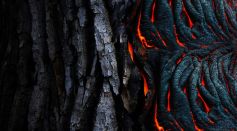ENVIRONMENT & CLIMATE

SINAI Technologies, Decarbonization Startup, Raises $10M in Seed Funding Round
Earth Destruction: Is This Really Possible? Black Holes, Volcanoes, Robotics May Negatively Impact the Planet in the Future
Cells Discovered in Corals, Sea Anemones, Engulfing Bacteria; A Discovery Potential for Better Marine Health Assessment

Archaeogenetics in Croatia's Neolithic, Bronze Age Possible Missing Piece of European Ancestry

Measuring Firebrands: New 'Emberometer' Uses 3D Imaging Techniques To Assess Wildfire Threats
Red Junglefowl Experiment Reveals Genetic Expression and Cognitive Enrichment Influence on Impulsivity
[Watch] Alaskan Bear Wandering Around With Up to 9 Meters Long Tapeworms Hanging From Their Butts

Supporting Evidence of Earth's 200-Million-Year Magnetic Field Cycle Discovered from Lava Flows
Siberian Wildfires Produce 800 Megatons of Carbon Dioxide in Less Than 3 Months

'Hobbit' Species Unearthed in North America, Evidence of Mammalian Evolution After Dinosaur Extinction
Tennis Ball-Size Giant Turtle Egg Opened for the First Time to See the Rare Embryo Undisturbed for 90 Million Years

Pompeii Tomb Reveals Perfectly Preserved Mummy of Slave-Turned-Cult Priest, Other Evidence of Cultural Diversity

Two Albino Baby Alligator Eggs Hatch in Florida Zoo; What Cause This Loss of Pigmentation in Animals?
Cuttlefish: Extraordinary Sharp Memory of Sepia officinalis Breaks Aging Limitations
Most Popular

Will Earth's Magnetic Poles Flip Next? Magnetic Pole Reversal Explained Through Cutting‑Edge Magnetosphere Science

Relativity Time Dilation Explained: The Physics of Time and Why It Moves Differently in Space

How Lightning Science Reveals Why Charged Storms Are Rising with Global Warming Effects

How AI Is Used in Weather Prediction: Smarter Forecasting Through Machine Learning




